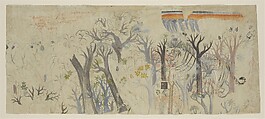Study for a Tiger Hunt
Sheikh Taju Indian
Not on view
The court artists of Kota, developed a unique landscape style distinguished by a deep empathy for the rugged terrain and dense foliage of the Kota territories. This is a harsh landscape dominated by lightly wooded hills and steep rocky ravines, and populated by lions, tigers, bears, and boars. In this setting, these royal hunters appear as unwanted intruders and predators, setting traps for the noble animals whose domain this is. Here we see a Kota ruler, possibly Maharao Umed Singh (r. 1771–1819), barely visible amid the craggy trees, aiming his rifle at the tiger being driven within range by a line of beaters behind. The mighty beast appears to growl threateningly at this assault. The pitching of royal hunter and noble beast in deadly combat was seen in Rajput court culture as an important expression of kingly bravery and martial strength. The hunt came to replace the battlefield as the arena for defining their manhood and right to rule.
This work is attributed to the most famed of the Kota hunt-painters, Sheikh Taju, and bears a date equivalent to 1780. This work is clearly a study, in all probability intended as a cartoon to be translated into a mural painting. Court painters were expected to participate in the hunts, as they were in military campaigns, and chronicle the brave deeds of their patrons.
Due to rights restrictions, this image cannot be enlarged, viewed at full screen, or downloaded.

